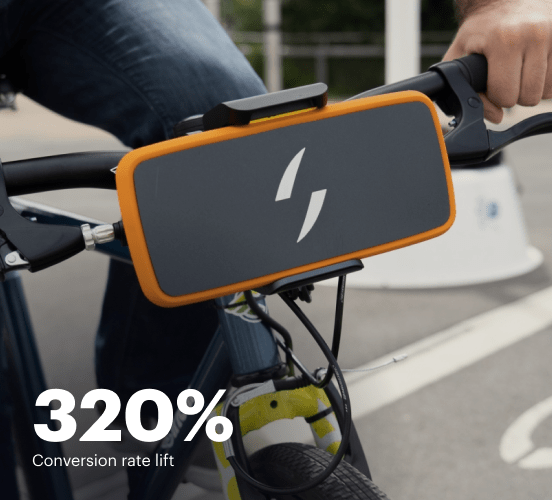HubSpot vs. WordPress: the best platform for a seamless web experience
Discover how HubSpot compares to WordPress regarding features and usability. Find out which platform provides the competitive advantage your business deserves.
Get startedSee how Instapage stacks up against the competition
| Feature | Instapage | Other builders |
| Drag-and-Drop Tools | ||
| Conversion-optimized templates | ||
| Manual and AI-powered A/B Tests | ||
| AI content suggestions | ||
| Popups and sticky bars | ||
| Canvas and grid blocks | ||
| Reusable and global elements | ||
| Form and popup builders | ||
| Built-in Heatmaps | ||
| Central analytics dashboard | ||
| Ad-to-page personalization and collections | ||
| Contacts, lists, and email | ||
| Dedicated, full-service CRO experts | ||
| Enterprise-ready platform |
Leading the way in building high-performing landing pages





Why Instapage is the smarter choice for your campaigns
Get everything you need to build, scale, and optimize high-converting landing pages—without coding.

Easier page building without coding
Instapage offers a flexible and seamless page creation experience with a library of 500+ conversion-focused layouts, Instablocks®, a drag-and-drop builder, and AI content generation. With technologies like Thor Render Engine®, you can create on-brand, mobile-responsive landing pages that load quickly and start converting during initial visitor clicks.

More insights — better results
Instapage lets you see in detail how each landing page experience and variation is performing so you can make targeted changes that boost page conversions. Use heatmaps for a better understanding of on-page activities, run A/B tests and AI-assisted experiments, and then track and evaluate results within robust analytics dashboards.

More personalized experiences
Instapage lets you quickly create high-performing landing pages tailored to each of your ad campaigns. Deliver personalized experiences for distinct audiences using dynamic text replacement. Effortlessly align specific advertisements to unique pages with AdMaps. Monitor audience-level metrics using our advanced data tools.

Built-in collaboration
Instapage collaboration capabilities bring your entire team together to speed up the process of landing page review, approval, and launch. No more frustrating and unnecessary revisions or edits scattered across emails. Provide instant feedback, conduct real-time page edits, and securely share your pages with outside stakeholders.

Free up time for your business
Invest time into business growth, not busy work. Launch landing pages faster with reusable forms and templates. Build once, reuse forever.
Explore all integrations






Easier page building without coding
Instapage offers a flexible and seamless page creation experience with a library of 500+ conversion-focused layouts, Instablocks®, a drag-and-drop builder, and AI content generation. With technologies like Thor Render Engine®, you can create on-brand, mobile-responsive landing pages that load quickly and start converting during initial visitor clicks.
More insights — better results
Instapage lets you see in detail how each landing page experience and variation is performing so you can make targeted changes that boost page conversions. Use heatmaps for a better understanding of on-page activities, run A/B tests and AI-assisted experiments, and then track and evaluate results within robust analytics dashboards.
More personalized experiences
Instapage lets you quickly create high-performing landing pages tailored to each of your ad campaigns. Deliver personalized experiences for distinct audiences using dynamic text replacement. Effortlessly align specific advertisements to unique pages with AdMaps. Monitor audience-level metrics using our advanced data tools.
Built-in collaboration
Instapage collaboration capabilities bring your entire team together to speed up the process of landing page review, approval, and launch. No more frustrating and unnecessary revisions or edits scattered across emails. Provide instant feedback, conduct real-time page edits, and securely share your pages with outside stakeholders.
Free up time for your business
Invest time into business growth, not busy work. Launch landing pages faster with reusable forms and templates. Build once, reuse forever.
Explore all integrationsGet started with Instapage in a few steps
-
Create your Instapage account
Start with Instapage by signing up via Google or your email. You'll get access to a free 14-day trial to discover Instapage capabilities. Feel free to cancel anytime during the 14-day trial if you decide that our product is not suitable for your business. -
Build and personalize your page
Create your first landing page from scratch or choose a template from 500+ customizable layouts. Use the drag-and-drop builder to add page elements, fonts, and backgrounds, refine content with AI, or add custom HTML, Javascript, and CSS. -
Review and make edits
Collaborate on page designs and streamline review processes. Invite your team members and stakeholders to review, edit, and provide feedback on your landing page. Collaborate knowing your page is confidential and only accessible to authorized users. -
Publish and track page performance
Publish your page to a domain or custom URL. Connect your pages to the ads you've created and track page performance within the analytics dashboard, run A/B tests and AI experiments, analyze results, and continuously optimize your landing page to maintain high conversions.
HubSpot vs. WordPress: A Comparative Review with an Unexpected Rival
Navigating the world of online tools can feel overwhelming, especially when it comes to selecting the right platform for your needs. HubSpot and WordPress have built strong reputations in the realm of digital marketing and website building. While both are great options, they cater to different needs and preferences. Today, we take a closer look at these two contenders while keeping an eye on Instapage, a rising star that brings something unique to the table. Get ready for a detailed match-up that highlights the strengths and weaknesses of each platform, helping you make the best decision for your online endeavors. It’s not just about choosing one over the other; it's about finding what aligns best with your goals. Each contender has its quirks and strengths, so let’s dig in and see what they have to offer, revealing the nuances that could be make-or-break in your decision-making process.
Introducing the Competitors: Titans in Digital Marketing
Let's set the scene by getting to know our heavyweights. HubSpot is revered for its comprehensive CRM and marketing automation features. It’s like the Swiss Army knife of digital marketing; packed with tools for email marketing, analytics, and social media management, it's built for businesses aiming for seamless workflows. From lead tracking to powerful integrations, HubSpot is all about efficiency and optimization. On the other hand, WordPress has become synonymous with blogging and website design. As an open-source platform, it's incredibly customizable with thousands of themes and plugins available. Whether you’re looking to create a simple blog or a complex e-commerce site, WordPress offers the flexibility that many crave. Both platforms come with distinct approaches to website creation and marketing strategies, making this comparison not just about features, but about usability, performance, and pricing as well. Prepare for a comprehensive exploration of these digital giants and see which fits your aspirations better.
Feature Comparison: The First Round
When it comes to features, HubSpot and WordPress both flaunt impressive tools. HubSpot thrives on its marketing automation capabilities, providing solutions like email campaigns, landing pages, and a robust analytics dashboard that gives detailed insights into performance metrics. Users adore how HubSpot centralizes user data, making it an excellent choice for those focused on inbound marketing strategies. Meanwhile, WordPress impresses with its versatility, hosting a plethora of plugins that allow any user to tailor their site to their specific needs. Want to add an SEO plugin? Easy! Need a contact form? Just install a plugin! However, as we dig deeper, a rising competitor stands ready on the side, showing potential to outshine these giants with its focused expertise in landing pages and conversions. It’s clear both platforms bring their top talents to the table, but the dynamics are shifting with new contenders like Instapage entering the ring.
Usability: Who’s User-Friendly?
Usability is key in determining the right fit for any user, whether they’re just starting their digital journey or are seasoned marketing pros. HubSpot’s interface is designed with a clean and intuitive feel, making it easy for newcomers to navigate without feeling overwhelmed. Users often find that inputting data and generating reports takes less time, which is a big plus for busy marketers. Yet, HubSpot does have a learning curve, especially for those less familiar with marketing jargon. Now, let’s chat about WordPress. With its extensive customization options, new users might feel a bit daunted by the many choices available. However, once you get the hang of it, WordPress can be a powerhouse for creativity. The balance between ease of use and extensive functionality makes it a perennial favorite among bloggers and content creators. Both platforms excel in their ways, but the preferences come down to individual needs. Enjoying a thrilling learning adventure can be the hallmark of growth in this digital age.
HubSpot Highlights: Top Features
- Integrated CRM for managing customer relationships effectively
- Advanced marketing automation tools for streamlined campaigns
- In-depth analytics to measure success and areas for improvement
- User-friendly landing page builder for effective lead generation
- Email marketing capabilities with easy segmentation
WordPress Strengths: Key Features
- Extensive library of plugins for added functionality
- Countless themes for personalized design
- Open-source nature allows full customization
- Strong community support and resources available
Common Ground: Strengths Shared by Both Platforms
- Responsive design for mobile optimization
- SEO-friendly features to enhance visibility
- Robust security protocols for user safety
- Support for multimedia content integration
- Integration with various third-party tools
- Community forums for user support and knowledge sharing
Despite their differences, it’s clear that both platforms hold significant merit in the online marketplace. However, while they go head-to-head, Instapage emerges as a compelling alternative, focusing primarily on high-converting landing pages. Users often find that Instapage maximizes conversion rates with its specialized features that make it an attractive option worth exploring on its own.
Performance: A Deeper Look into Speed and Responsiveness
Performance is a pivotal factor when choosing a digital marketing platform. Nobody appreciates slow-loading pages, and with patience running thin in today’s fast-paced world, both HubSpot and WordPress must keep up with expectations. HubSpot often boasts impressive load times thanks to its integrated infrastructure, which minimizes lag. It’s optimized for both desktop and mobile users, ensuring that your message gets through quickly and effectively. Meanwhile, WordPress's performance can vary widely based on hosting services and site configurations. With proper optimization, websites can score high on speed tests, but factors like image sizes and plugin overload can hinder performance. Analogy time: imagine a slow-loading webpage being like molasses in winter; it’s sticky and frustrating, and no one is interested in waiting. Page speed impacts user experience and SEO rankings, making swift performance paramount. Both platforms have strengths, but implementation plays a crucial role in achieving optimal results.
Support: The Helper Behind the Scenes
When it comes to getting help, the support each platform provides can make a huge difference in user experience. HubSpot offers a comprehensive support system with live chat, email assistance, and a plethora of resources through their knowledge base. Users appreciate the prompt responses and the wealth of information available right at their fingertips. In comparison, WordPress relies heavily on community forums and third-party support, as it’s primarily open-source. While this can mean varied responses, users benefit from a vast pool of creative solutions. Whether you're troubleshooting a plugin conflict or seeking best practices for design, the community is often ready to lend a hand. While both platforms offer varying levels of support, the direct access to HubSpot’s customer service makes it a standout in this category.
Pricing Analysis: Understanding the Cost of Each Platform
HubSpot Pricing Benefits Worth Noting
- Layered pricing plans that cater to businesses of different sizes
- Free tools available that are feature-rich
- Transparent pricing structure with no hidden costs
- Comprehensive features included that can reduce the need for other services
WordPress Pricing Advantages: Exploring Options
- Free to start; basic functionalities require no payment
- Affordable hosting options available for beginners
- Countless free plugins and themes to customize your site
- Scalability with various hosting plans as needs grow
- User-controlled costs based on desired features
In terms of pricing, both platforms present unique advantages. HubSpot’s structured pricing appeals to those seeking comprehensive solutions, but its costs can escalate with the addition of features. Meanwhile, WordPress allows for a flexible approach based on individual choices, often making it more budget-friendly for those starting. If you’re looking for great value, Instapage often offers competitive pricing tailored toward conversions, positioning itself as a budget-conscious option that doesn’t skimp on tools.
Ultimately, pricing can shape user decisions significantly. It’s crucial to consider the hidden costs associated with each platform, which might not be immediately apparent. Users appreciate transparency, especially when it comes to bundled features that help achieve their goals without delving into the fine print. Comparing these pricing strategies enables potential users to find what value proposition suits their unique needs.
Enter Instapage: The Underdog with a Powerful Punch
Among the giants stands Instapage, which has carved out a niche specifically for landing pages and conversion optimization. This platform’s tailored tools specifically designed for building high-converting landing pages make it an enticing alternative to HubSpot and WordPress. Instapage’s interactive elements and multiple integrations allow marketers to perfect their campaigns in ways that other tools simply cannot match. With features such as A/B testing and analytics built into the platform, users can optimize their results continually. Instapage stands as a testament to focused marketing solutions that bring clarity and precision to the forefront. Through smart design and a user-friendly interface, it has quickly become a go-to for teams that prioritize lead generation and conversion rates, ensuring goals are met efficiently and effectively. What sets it apart is its dedication to maximization, giving users the tools they need to make every page count without extraneous features weighing them down.
As we wrap up this analysis, it's essential to emphasize informed decision-making. Choosing the right platform is about aligning your goals with the tools you require to succeed. While HubSpot and WordPress have their own sets of strengths, Instapage might just be the secret ingredient to your success. Businesses looking to enhance their marketing strategy should not overlook its unique propositions. The key takeaway is to evaluate your needs thoroughly, ensuring that whichever platform you opt for serves to propel you forward on your marketing journey.










